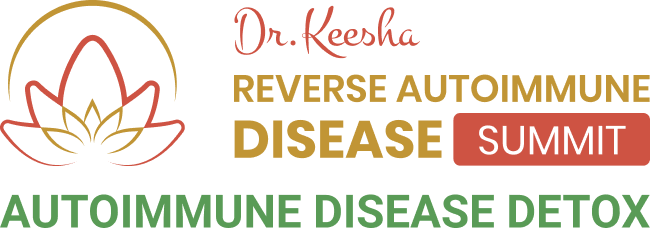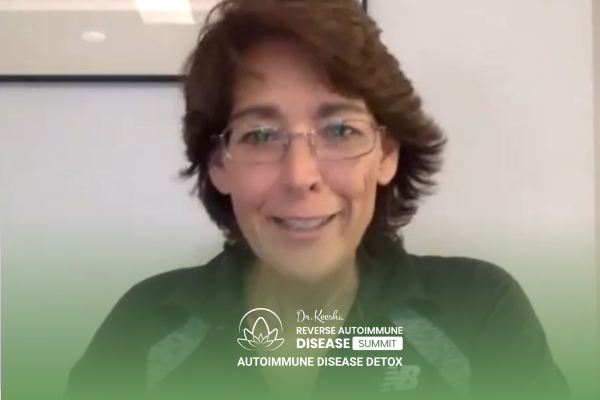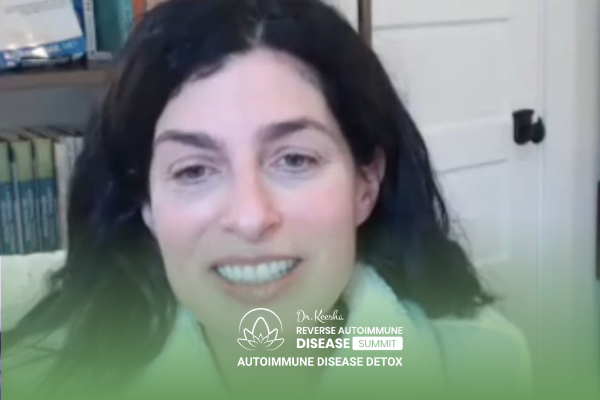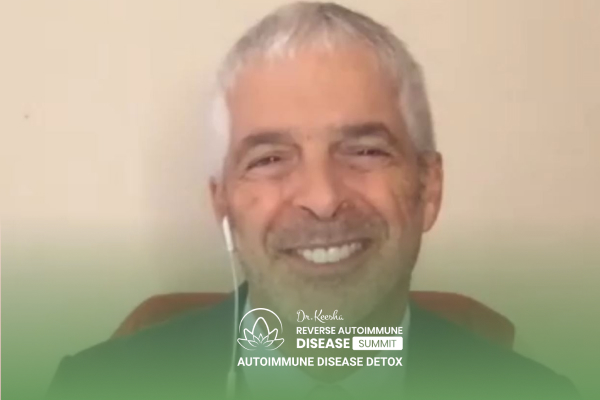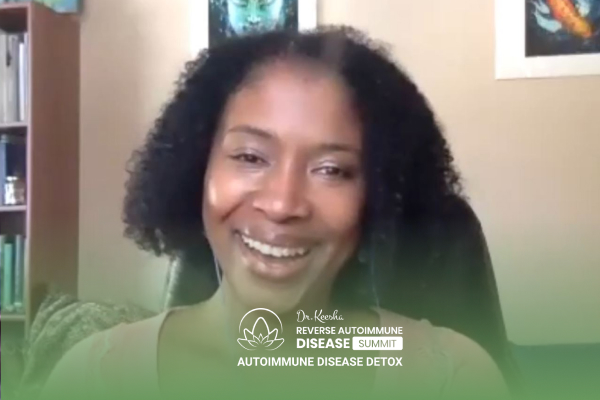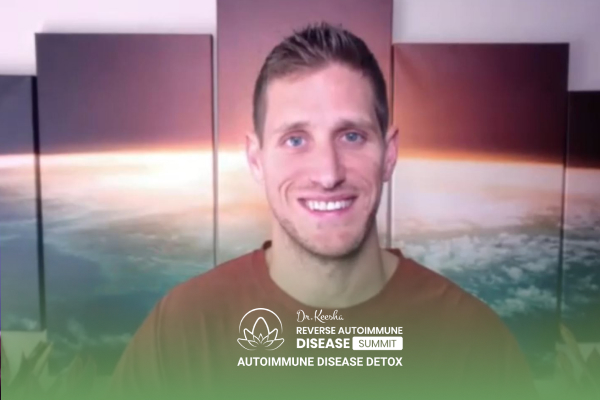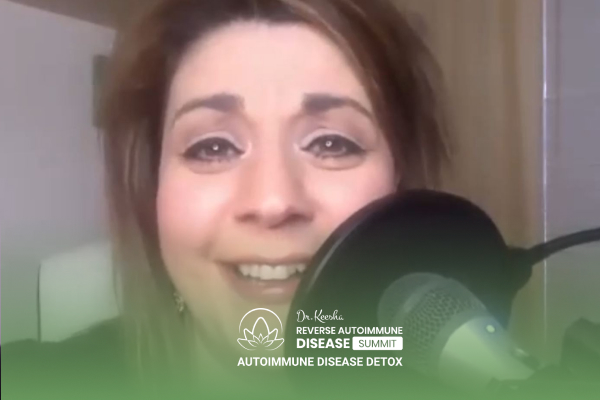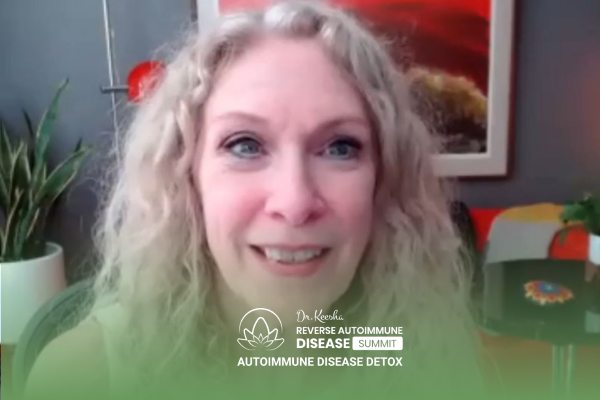Join the discussion below
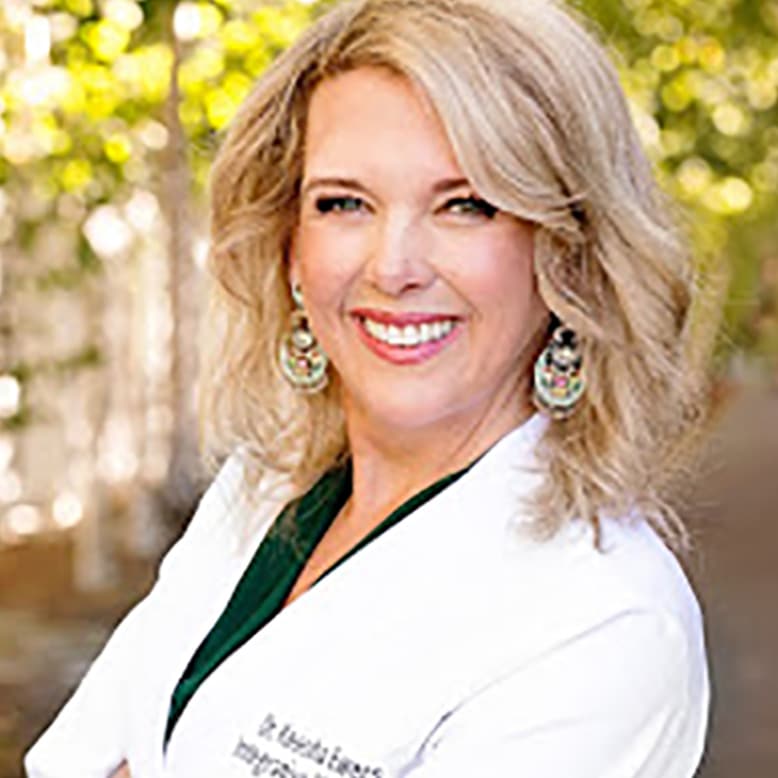
Keesha Ewers, PhD, ARNP-FNP-C, AAP, IFM-C
Dr. Keesha Ewers is an integrative medicine expert, Doctor of Sexology, Family Practice ARNP, Psychotherapist, herbalist, is board certified in functional medicine and Ayurvedic medicine, and is the founder and medical director of the Academy for Integrative Medicine Health Coach Certification Program. Dr. Keesha has been in the medical field... Read More
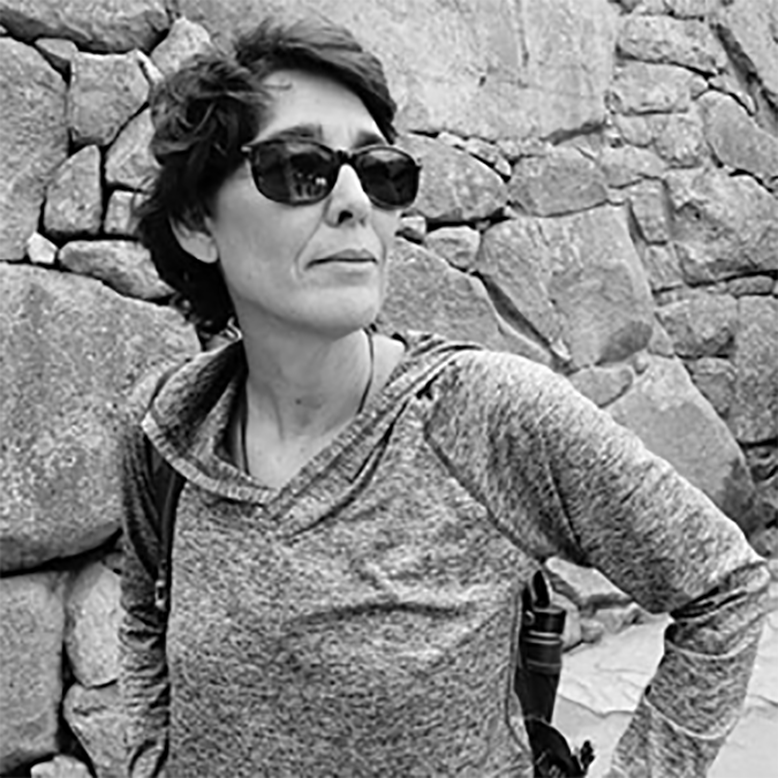
Michelle Toole is the founder of Healthy Holistic Living. She started the website in 2006 to share her exploration of natural and alternative health solutions when mainstream medicine offered only basic symptom relief for a mysterious neurologic condition that within weeks took her from running the New York City Marathon... Read More
- How Michelle went from running marathons to being bedridden in a matter of weeks
- How to detach your autoimmunity from your identity
- How to overcome the loss of friends and family due to autoimmunity
Related Topics
Autoimmune DiseaseKeesha Ewers, PhD, ARNP-FNP-C, AAP, IFM-C
Welcome back to the Reverse Autoimmune Disease Summit, everybody, of course this is 4.0 reverse autoimmune disease. And we’re talking about the autoimmune detox today. And I’m really happy to bring a new friend and colleague of mine to you, her name is Michelle Toole. She’s the founder of Healthy Holistic Living. She started the website in 2006 to share her exploration of natural and alternative health solutions when mainstream medicine offered only basic symptom relief for a mysterious neurologic condition, that within weeks took her from running the New York city marathon to being bedridden, and giving up her position as executive director of a social services, nonprofit and Arizona. Her journey as an information seeker resonated with thousands of readers as she followed a holistic path and experienced profound improvements in her physical, spiritual, and mental wellbeing against the illness that took 20 years to diagnose as multiple sclerosis. Fast forward to today, we see that helpline named Healthy Holistic Living is one of the best holistic health blogs of 2020, and now has over 2 million passionate followers. Welcome to the summit, Michelle.
Michelle Toole
Thank you, I appreciate you having me here.
Keesha Ewers, PhD, ARNP-FNP-C, AAP, IFM-C
You know, I’m gonna get into your story but I just wanna tell our viewers that I’m doing a little comic relief this morning because just before I got onto Zoom with Michelle, I ate some paleo German pancakes with fresh blueberries and I now have purple teeth. So when I smile, which I do a lot, and laugh, which I do a lot, you can see blue teeth. And I thought it was kind of a funny way to start the interview. So Michelle, you and I, I was training… I can’t remember which marathon I was training for that I wound up all of a sudden bedridden, which is a very interesting way of thinking about autoimmunity because of course it’s untrue. It’s doesn’t sneak up on us all of a sudden, it’s been happening for years and years and years, but it is how we experience it, you know. So going from training and running to all of a sudden, I can’t get out of bed is quite a change. So I’d love to have you tell a little bit about your story.
Michelle Toole
Sure, yeah, it was an enormous change. I mean, as you know, somebody who’s, you know, running marathons to go from that huge transition is life altering to say the least. And for me it, you know, upon reflection, sure, there were a lot of signs.
Keesha Ewers, PhD, ARNP-FNP-C, AAP, IFM-C
Yeah.
Michelle Toole
But definitely in that moment, I was actually out on a training run. And I was, I don’t know, maybe on mile five and the left side of my body went numb, and the right side of my body went weak. And, you know, I stopped running and I’m kind of, you know a little bit in shock, you know, made it back home. And it was just from that day forward everything just cascaded. You know, I mean, it just… Everything could blow up, every autoimmune response your body could have, I had. I mean, from going into massive allergies and sneezing, it was just this unfolding and unraveling of my entire life in a month, you know? And so I didn’t end up initially bedridden right away, it was just a cascade of events. And as you’re struggling to kind of hang on for the ride, you know, you enter into kind of a new world. First, it’s just complete and utter fear-based, ’cause you have no idea what’s going on. And then you go into the medical system and you go into shock, but they don’t know what’s going on because you actually believed, you know, at 32, I had no understanding that that illness is still a mystery.
Keesha Ewers, PhD, ARNP-FNP-C, AAP, IFM-C
That’s how old I was too.
Michelle Toole
Wow, that’s kind of odd.
Keesha Ewers, PhD, ARNP-FNP-C, AAP, IFM-C
I know, I know, I was on my way to go to the Disney World Marathon. Bags were packed and I already done my 20 miler, I was taking off the next day.
Michelle Toole
I had actually was heading to the Disney world Marathon. I was heading to it and had to cancel it and got an MRI instead.
Keesha Ewers, PhD, ARNP-FNP-C, AAP, IFM-C
Same here.
Michelle Toole
My partner ran it, and I was in getting an MRI when they were running. And that… I don’t even know what year that would be 20 years ago, but yeah, 2000, 2001 right around there. And yeah, that was the one I was training for, it was the next one, it was the Disney Marathon. That’s weird that we have a lot of alignment, but anyway-
Keesha Ewers, PhD, ARNP-FNP-C, AAP, IFM-C
Yeah, it’s pretty interesting. And my doctor when I went in that day had the answer, she said, “Do you have any autoimmunity in your family history?” And I said, yeah, I think my grandfather who died at age 55, which I am right now, had rheumatoid arthritis and was in a wheelchair. And she just like close the book put it on the shelf, said, “Well, it’s genetic, my dear, you’ve got rheumatoid arthritis, and here’s, you know here’s methotrexate prescription, here’s a nonsteroidal anti-inflammatory drug, when you get worse comeback.”
Michelle Toole
Wow.
Keesha Ewers, PhD, ARNP-FNP-C, AAP, IFM-C
When, not if right. And I was like, time out, time out, I’m really disciplined. Like I just ran 20 miles the other day at 3:00 AM. Like I do this stuff. I make my own food, you know? And she said, “No you just drew the short end of the genetic lottery.” Right, that’s it.
Michelle Toole
Well, yeah. And that’s your first introduction, you know, you were lucky in that sense I think to… Maybe lucky and maybe unlucky, I don’t know, because I don’t believe a label necessarily serves us. We believe that it does at the time when we’re grasping at things.
Keesha Ewers, PhD, ARNP-FNP-C, AAP, IFM-C
I think it was helpful because I had an answer to start with, rather than some, I don’t know what’s going on with you, which would have been terrible. Right, so I had a place to start going into pub med with a name and a face to put to it. And I was able to reverse it within six months, I haven’t had rheumatoid arthritis since then. Right, but I think having that label was really important, which is why my patients when I do diagnose them with a specific ICD-10 code related disease process, sometimes burst into tears, because they’re happy to have an answer but then I’m the one saying, wait now I don’t want you to latch onto this, right? This isn’t actually what this is, it’s your immune system attacking you in whatever target tissue is the name, but actually there’s something else we need to be dealing with here.
Michelle Toole
Right, and arrived at that point, not having a diagnosis. There was one of the… It’s an interesting process and it unfolded, and it’s very dramatic when you go from high functioning to zero. I literally ended up on disability. And for somebody, with my mindset and how I conduct life, it was crushing. And, you know, the emotional experience with the onset of anything is really trying. You know, one of the things for me is I always say is I lost all my I’s. You know, I was a runner, I was an executive director, I was an athlete. You know, I was all these things-
Keesha Ewers, PhD, ARNP-FNP-C, AAP, IFM-C
Your identities.
Michelle Toole
Every aspect of my identity had been stripped away in my mind. And then you had no new word, okay. Which is I have arthritis, or I have an autoimmune disease, or I have… So I was just floating in this space of no I’s, no identity, no sense of self, and I-
Keesha Ewers, PhD, ARNP-FNP-C, AAP, IFM-C
I’m sick, and that’s all I know. I’m weak.
Michelle Toole
Well, and I struggled because I didn’t attach to those things, but it certainly… I lost friends, I lost jobs, I lost everything. We had to move because I wanted… We were out in Arizona, we flew into people at Hopkins to see if they could help. And you deal with a lot of doctors that have a… Their first instinct, they don’t come back with a test, they don’t have something definitive, is it necessarily a physical reaction? So they’re looking for emotional, looking for all these components. And unfortunately there’s trauma associated with that. So now you’re having new trauma on top of what you were already walking through.
So, you know, it became clear to me after I was put on a slew of medications that weren’t working, and had just unbearable side effects. I mean, one of the biggest challenges for me was dealing with pain, you know, and how to deal with what I felt was pain that was excruciating. How do I just get to the mailbox, or get to the kitchen or get through an hour each day? And so all of this is swirling you as you as life is going by. And so a year went by, and they felt that it might be, I had a nine-inch cyst wrapped around my spinal cord and they thought that might be why one of my legs wasn’t functioning completely.
Keesha Ewers, PhD, ARNP-FNP-C, AAP, IFM-C
That would be a good answer.
Michelle Toole
It would, and we had surgery, not a wise decision at the time, and it triggered a huge MS flare, ended up bedridden. And then, you know, you’re just curled up, cause your spine… You know, so just another cascade on top of everything else at the bench. And that’s really where I was bedridden and just lying there one day and I thought a couple of things kind of floated through my mind, which is, you know, a sense of value for myself. And I would say to myself, you know I’m valuable enough just simply to exist. I don’t have to be an aunt, I don’t have to contribute, I don’t have to be anything other than where I am dealing with what I have in front of me. And I started reading, and I knew I had to take myself off all the meds, pain, medicine, everything. And I just started doing it one at a time.
And now mind you at the same time I’ve tried every single alternative health practice you can think of, Chinese medicine, TT, you name it, there isn’t anything I haven’t tried, gave everything a good period of time. So you’re also going through all this at the same time, and pain was still my dominant. And so I read a book on pain, and I wish I could remember the name of the book. Because it helped me understand the relationship between your physical experience and your thoughts and your emotions and your sense of self and wellbeing and disease. And so the book had talked about how pain, it grows.
You can make it grow, you can make it slow, you can make it have a life of your own. It explained kind of phantom pain and the idea of interrupting pain signals. So it was trying to make things as tangible as I could so I could shift them in some capacity. And so pain was my first thing that I started with. And I remember learning at one point that you can put pain… You can have pain and put it over here and sit beside pain. And one of the things that we do when we’re sick is we dialogue with every experience we’re having. So having pain, we go, “Oh my God, this is terrible, I’m in so much pain.” And so you’re kind of reinforcing that network, that-
Keesha Ewers, PhD, ARNP-FNP-C, AAP, IFM-C
And it’s my pain.
Michelle Toole
And it’s my pain.
Keesha Ewers, PhD, ARNP-FNP-C, AAP, IFM-C
You own it.
Michelle Toole
You’re identifying with it. And you tend to grab them because you’ve lost all your identities, right? So, it’s a reactionary pattern. And so I realized that I was really actually feeding the pain, and it was getting loud and louder. Now, there certainly was a trigger, there was that initiated the pain cycle. But I now then embodied that and carried that through. I now owned that and had a relationship with that.
Keesha Ewers, PhD, ARNP-FNP-C, AAP, IFM-C
And a muscle memory.
Michelle Toole
Well, and a muscle memory. So not only is the neuro pathway to the muscle memory, you have all of this experience. And literally you could have an out of body experience and still have the pain because you’ve created that cycle. I didn’t start it. It’s not what… You know, and it’s a hard dialogue to have with people. They’re like, “But I’m not causing it.” I understand that.
Keesha Ewers, PhD, ARNP-FNP-C, AAP, IFM-C
“You’re saying, it’s my fault.” I’ve heard that a lot. This is not about blaming and shaming, this is not about fault, this is not about any of that. It’s like natural consequences to actions, it’s that’s simple
Michelle Toole
For my brain, it helped to make it physical. They didn’t want to have a reactionary emotional experience, which is, it’s not my fault. So after reading the book, I just said, okay, let me put this in a physical box so I can maneuver through this. And I was able to get the pain under control. I was able to do sensory experiences to an interrupt signals. You know, when you begin to understand that, and then kind of change that neural pathway, you know? And so that was one of the starting points for me, along with, at the same time, I read “Molecules of Emotion” by Candace Pert. Right there, it said so much. First it was my first introduction to mitochondrial, you know, helps in the understanding of your relationship to emotions and neural pathways, everything in your body, you know. And I felt, you know, obviously there is something physical happening. It was really, really clear to me that one, I’m on a team on my own here, I’m by myself, if I want something different, I’m gonna have to figure this out. I’m gonna have to figure out a path. I knew food was essential, I knew those were the obvious things, you know, to cleanse your diet, remove all the toxins, you know, feed your cellular health, that I didn’t need anybody to teach me about.
Keesha Ewers, PhD, ARNP-FNP-C, AAP, IFM-C
That is a really good, like just to hear if everyone can track that, I always say, start with food, ’cause it’s the thing you can control the easiest. Start with food, right.
Michelle Toole
Start with a physical start with something tangible. You feel empowered again, you feel, like you have the ability to do something.
Keesha Ewers, PhD, ARNP-FNP-C, AAP, IFM-C
Right, but you don’t end with food so much more.
Michelle Toole
No you don’t. Well, and actually, for me, you know, people say, well do you think you heal from MS. I think it’s ongoing, I think there are layers everything, and it may be 20 years now, and 20 years later something different happens. But what I do know is that I arrived at a point of having to kind of create a system for myself and a better understanding of living differently and living wholly and really living in the moment. And for me, the idea of… There are things that cause pain caused disease resistance, resistance to your current experience, and having the emotional, spiritual and physical reaction to that is perfect feeding ground for disease. It’s the perfect soil to grow disease and maintain disease.
Keesha Ewers, PhD, ARNP-FNP-C, AAP, IFM-C
There’s another aspect to that. I love what you’re saying because that, you know there’s the saying what you resist persists, but there’s also this piece around you mentioned that they didn’t use the word. And I kind of want to point it, is that people will often feel betrayed by their bodies when the I’s start going away. The roles, the hats, the, you know, the identities, when disease changes that then they feel betrayed by the body that they’re living in. And so when you’re resisting your body, that’s what autoimmune disease is. It’s you at war with yourself, right? And there’s no winner. And so, you know, after resistance will often come this huge resentment to the body, to the medical profession, to other people that are alive and well and doing what you used to, you know, like resentment to me is the most toxic chemical that there is on the planet.
And, you know, it’s not produced by big corporations and thrown into the air, soil and water is produced here, and then your cells are in the hot tub, you know. You’re bathing yourself in that. And that resistance, that feeling of betrayal, that resentment, that’s that space where you have to move, you know, take the plug out of the bathtub, let that drain, and then start bringing in some appreciation and gratitude for what is right where you can heal. So that’s why I say it goes way beyond the food that you’re putting in your mouth, and it goes into how you’re digesting your emotions. What’s your food for thought? Like, what is that, what’s that happening right now?
Michelle Toole
Well, and we store it.
Keesha Ewers, PhD, ARNP-FNP-C, AAP, IFM-C
Yeah.
Michelle Toole
We’re not trained… We don’t grow up learning that emotions are kind of a natural reflex and they should be flowing through your body, we’re not taught that.
Keesha Ewers, PhD, ARNP-FNP-C, AAP, IFM-C
We resist them.
Michelle Toole
We resist them. And you know, and we’re taught that not only do you resist them, but you either grace them or start analyzing them, because they must be attached to some horrible story in your childhood that you need to let go of. So we just keep storing and storing and storing, and the natural flow of the body for anything, energy going through you, emotions going through you, food going through you is in and out. And when we stop that, again, it’s the fertile ground for disease. You know, are I firmly believed and always believed that that our natural state is health.
Keesha Ewers, PhD, ARNP-FNP-C, AAP, IFM-C
Yeah, and emotional constipation is just as bad as physical constipation for you.
Michelle Toole
There you go, well, I think that I have the perfect… I created the perfect environment, and I absolutely believe that I’m a co-creator of what my experience is. And I absolutely believe that I was a participant in creating MS, and my experience in any autoimmune disease. That’s my belief system. But I walked that direction because in that belief, it allows me to also be empowered to understand that I can change that. And if I believe it happened to me, I’m powerless. And so I have to own that. It’s not saying that I did it’s my fault, or I did this to myself or any of that, but I created the groundwork for it to come out and be expressed. And it’s been a great experience because I wasn’t living me. I wasn’t living me. And living me is letting everything flow through me and letting everything IX, having area every experience. We’re taught to fight disease. Mainstream culture, every promotional out there you get cancer, fight it, fight it, fight it-
Keesha Ewers, PhD, ARNP-FNP-C, AAP, IFM-C
War on drugs, the fight on cancer. But yeah, it’s all that kind of language. And I’m always telling people like I’ve been fighting with my weight my whole life. And I’m like, oh, you know that language right there.
Michelle Toole
It felt a little, like I do little tricks for myself. And there’s one… You know, one is stop resisting, two is accept. We tend to believe if we accept the experience that’s happening around us, we allow ourselves to be a victim of it. And that’s not what I mean by accept. This is the current reality that’s unfolding. That’s what I mean. If I’m dropped in the middle of a war zone, I have to accept that I’m in the middle-
Keesha Ewers, PhD, ARNP-FNP-C, AAP, IFM-C
In the middle of the war zone.
Michelle Toole
Right, so you stop resisting, you accept and then you create. That simply is the path that almost every experience. Whether coming out of disease or creating business, or relationships or anything. Because if we resist, we shut down, we’re not accepting reality for what it is. And that’s the majority of our cultural training. You fight, you thrive, you succeed. Now because you’re a tenacious human that might have the fight in you, you might be able to overcome cancer, you might be able to overcome an autoimmune disease. The chance of it’s like coming back is really, really good or manifesting in another disease, and-
Keesha Ewers, PhD, ARNP-FNP-C, AAP, IFM-C
75% risk when you have one autoimmune disease that you’re gonna get another one, and it’s not because you’re just that genetically corrupt, it means that the very root cause that allowed the other one to blossom is still there.
Michelle Toole
Well, I don’t go into groups, I never have, I don’t dialogue about symptoms in disease. Well, when I didn’t get the validation of a disease, I excepted clearly this is happening to me, this is what I’m physically feeling, I accept that. And I don’t need validation for that. It is my reality, it’s not somebody else’s reality, and if they can’t see what’s happening or they can’t figure out a test to see what’s happening, I’m not gonna stop, I’m not gonna wait for that. Either we wait for that, or we group together with other people that are waiting for that, or can validate that space, and then we just stay there, like on the spin cycle, you know, and we get our I’s back, we get five 10 more I’s, so we feel a part of a community, we feel validated, we feel supported all the things we couldn’t manifest for ourselves, or couldn’t get from doctors or a current family, we’re doing that. And I can tell you when you’re in that cycle, you’re not going to let go of it because it’s now your identity. You have embraced disease as a part of your emotional, spiritual, and physical experience.
Keesha Ewers, PhD, ARNP-FNP-C, AAP, IFM-C
Social structure too.
Michelle Toole
That’s huge. And when you identify with social structure and you feel compelled to be a part of that, you know, you really just stepped into a minefield. That’s my experience. And that doesn’t mean that groups aren’t powerful, and helpful in a lot of ways, but if all we’re doing is, “Oh, do you have this symptom? Do you have this symptom?” We’re gonna stay here together.
Keesha Ewers, PhD, ARNP-FNP-C, AAP, IFM-C
I have a private group called The Reverse Autoimmune Disease Institute, and, you know, it’s 5,000 people strong. And one of the things that I make sure doesn’t happen in that group is the sharing of symptoms as a reality. You know, that, no this actually is the same exact thing going on with this person, and this person and this person, and that root cause pieces where we go, right? So let’s make that, not your reality anymore. And I think that’s really important because if your social structure develops around your disease process, then you’re going to just continue to concretize it or solidify it.
Michelle Toole
If we wanna have all the friends that are around us, everybody’s broken, so we can all feel better about ourselves, you know, I mean, I went at it alone and I knew at the time the information available on the internet was really limited. I’m sure you explained that-
Keesha Ewers, PhD, ARNP-FNP-C, AAP, IFM-C
I had a dial up modem and I was asking genes, that was how I found my information.
Michelle Toole
Exactly what I had to dial up I think Mercola was on the internet at that time-
Keesha Ewers, PhD, ARNP-FNP-C, AAP, IFM-C
Mercola wasn’t even a blink in the eye yet, so yeah.
Michelle Toole
Yeah, you know, pre-everything, so finding out information was real… I mean, now, I mean, having, you know, like doctors around you and Terry Wahls and all these people are making such profound headway. And I just think, you know, I can’t be bigger cheerleaders for you guys because the isolation and the sense of trying to meet the roadmap you had to create for yourself before all of this, was huge, you know, and overwhelming.
Keesha Ewers, PhD, ARNP-FNP-C, AAP, IFM-C
The thing of it is that I do want to point out to people is that there isn’t a roadmap that’s right for every single person. There’s no one autoimmune paleo diet, that’s gonna work for every single person. We each have our own individual gut, microbiota and health. We have our level of toxins we’ve been exposed to, and what those are in our own organs of detoxification, how well they work or don’t work. We have our own genetics, you know, and we have our own trauma and the way that we deal with stress, like every single person has their own unique puzzle. That there are some basic things that we can start with. Right, we can start detoxifying the pantry and what we’re putting in our mouths. And so we can start looking at this piece up here, you know, do I feel betrayed by my body? Am I resisting? Am I fighting? Am I angry? You know, Ayurvedic medicine, one of the very first things that I learned when I went on the internet and started looking, was I found out Ayurveda.
I found a research article in PubMed for people with RA and yoga, and I’d never practiced yoga, I could barely bend over and touch my toes, I was so hamstring like tight it bands. I mean, I was a runner. And in those days there wasn’t a yoga studio on every corner next to a Starbucks, you know, it was very different. And I went to the yoga class the very next day and then he talked a little bit about this word Ayurveda. I went home, looked it up, and I found out the autoimmune disease according to your Ayurvedic medicine is undigested anger. It was so revolutionary to me. I was like this high intensity adrenaline junkie ICU nurse. who had never even thought of any of these things that we’re talking about today. I had like this drive and ambition and I was a perfectionist and my personal record was always against me when I was running. And, you know, just always driving, you know, and I think back to that 30 year old woman, and I just go, sweetheart honey.
Michelle Toole
Excuse the cultural pressures. You know-
Keesha Ewers, PhD, ARNP-FNP-C, AAP, IFM-C
But I mean even more than that, it’s like, what was it about you that you felt that you had to prove something so constantly, you know. And I can go back to my childhood and look at that and go, there it is, you know. And then heal that. Like that pressure, I just think about that pressure that I put on myself, and I think about my immune system and I say, oh yeah, I was constantly at war with myself and didn’t even realize it, you know.
Michelle Toole
I think for me, it was a natural consequence of losing all the I’s, because I allowed myself to sit with that without re identifying or reattaching to anything, that was the healing for me, not so significant what was the trauma that caused me to live that way. Which I’m not an advocate of having to identify that little tiny box somewhere and open the box, as much as I’m just sitting here completely without anything, and I’m accepting that, and accepting me without anything. This person that was on top of everything, it’s nothing. Like I’m laying there, I’m like, how did I end up here. You know, I’m using a wheelchair, I’m bedridden, brushing my teeth is the highlight of my day, you know. And you just think… You’re just shaking your head, but I allowed myself… And it was painful, brutally painful to have no I’s, no identity.
Keesha Ewers, PhD, ARNP-FNP-C, AAP, IFM-C
You know, I’m in a masters of divinity program right now just for fun because Tibetan Buddhism, I think has sort of like the technology that was the most advanced on this planet for training the mind, it’s really amazing. And so I’m in learning that right now because I’ve just been astonished. And one of the things that there’s a huge focus on is really accepting that they’re suffering, if you don’t understand that everything’s impermanent. And that everything that is born is going to die, everything created is going to deteriorate. And that impermanence is part of life.
And in our culture, we are not taught this from the time we’re knee high to a grasshopper. And you know, that idea our ego identification and I have a TED Talk that I was supposed to give, but then COVID hit, and it’s on disease as the graduated path to expansion of consciousness and evolution because it does stop us. And it acts as that teacher for this is not you, right, this is not you. And who are you without that? You know, and can you find that and access that? And it has nothing to do with achievement and productivity. We’re such a productivity-oriented society. And so what you’re pointing to is that, right, that you accepted the impermanence of all of it is.
Michelle Toole
And I realized that it’s inconsequential, all you is within what I call the you. For me if somebody, at whatever time someone wants to use that that had its inherent value, that I am whole and complete, I don’t need to be broken to myself to be a value. And that is our path. We come in, we struggle and strive and overcome, so we can be seen as having been evolved or achieving or whatever. And the path is really the opposite. We are a home, we arrived, and it is to realize that all of that is unconsequential.
Keesha Ewers, PhD, ARNP-FNP-C, AAP, IFM-C
And even with the illness, you’re not broken.
Michelle TooleToole
There’s no… You whole-
Keesha Ewers, PhD, ARNP-FNP-C, AAP, IFM-C
There’s no breaking happening.
Michelle Toole
Right, there’s nothing. And when it can no longer touch you, because that’s really what happens is it becomes over here, you know, and then it’s… You know, even if I can’t change it, I’m okay. And you begin to realize there’s this idea, this scale we’ve created which is kind of this up and down really is just, if you let it all just go this way, and you know, you’re no longer resisting, because resisting is about forcing it down that path of value, ego-based path that if I don’t, I’m not whole, I’m broken, this, it just all disappears. And it all dissipates and it’s all about, you know, just experiencing. There’s no good, there’s no bad, you know, even all through that horrific moment, you know, I liken to the idea of being on a ship, crossing the ocean to the new world, and the exhilaration of the ups and downs and the fear and all of these things that make it, this epic story. And I’m really just having an epic story. And if I end up in a wheelchair, it’s just the epic story.
Keesha Ewers, PhD, ARNP-FNP-C, AAP, IFM-C
Part of the Epic story, right.
Michelle Toole
Yeah, and so I’m exhilarated to see what I present next, what experience I have next with whatever my body is doing.
Keesha Ewers, PhD, ARNP-FNP-C, AAP, IFM-C
I had a patient not too long ago that is one of several over the years, you know, that have come with the same story where they had a near-death experience, and wound up going into this beautiful light with unconditional love and was met by a couple of deceased ancestors. And then came back into the body, made a choice and came back, and then started having anxiety. Because in the case of the, you know, this last person, it was because he’s also a athlete, very attached to the physicality of his body. And he was having an existential crisis about, well who am I, if I don’t have a body?
Michelle Toole
Wow.
Keesha Ewers, PhD, ARNP-FNP-C, AAP, IFM-C
And this shows me that I’m going to be without a body at some point, and this body I really like, and I’m attached to. And so my work with him was to actually align like, okay, the, you know, the impermanence of this body is real, and it is going to die. And, you know, can you grieve that and at the same time, hold intense appreciation and gratitude for how it’s serving you in this moment. No matter how that is? It may be in a wheelchair, and may be that the left side doesn’t work, it may be that the vision was not there, but this body is still functioning in a way that’s carrying your consciousness around on this planet. And can you, no matter what level or degree that, that is love it with that same unconditional grace that you felt when you were beyond it. You know, and pull that light into this dark period of anxiety.
And it was amazing because it just sort of like reattached and anchored this resource place of oh, right. And then not resisting, you know that this body is going to go, bye-bye, it’s going away, right. But your consciousness, as you’ve already witnessed, moves forward, you know, moves on. And you know, so whatever that means to you in terms of your spiritual paradigm and languaging and all of that, you know, there’s enough, very compelling. I know my work in hospice and in the intensive care unit in my earlier years, you know, I had so many people have stories like this, and I’ve had three near-death experiences in my own liKe that really does bring to bear like, oh yeah, this body is impermanent. And so therefore how much appreciation and gratitude can I hold in this breath that I’m breathing right now that not gone, right? That changes your biochemistry, it changes the feeling of betrayed to grateful, right. Which is a completely different thing. And I always say like, humans are so entitled. We think our bodies are supposed to behave in a certain way, but whoever promised that? No one ever said you’re getting out of this with your body intact.
Michelle Toole
You know, one of the challenges that I found with communicating with readers and followers on Healthy Holistic Living, was maneuvering somebody’s thought process not to see this as overly emotional, or overly spiritual kind of dialogue here. We are whole beings. And to be able to somehow marry the idea of the physical experience you’re having, with our responsibility to emotions and energy and life, and nature, how really this experience truly happens. I mean, you know, we can get into a dialogue about quantum physics, and how it really proves it out, you know, and how we-
Keesha Ewers, PhD, ARNP-FNP-C, AAP, IFM-C
And we might be having existence on a million different planes right now.
Michelle Toole
People, when you begin the dialogue or you take this information and break it down. So somebody who is a little more resistant to some of this dialogue, you know, to really embrace that it takes all of it, we know the food and realistically, it’s a path that’s pretty clear with that end. You know, you do have to identity… you have to start having a clear relationship with your body, from a physical experience. You have to understand what a symptom means to you, ’cause it is very different as you said to somebody else. So when this happens to my body, when a muscle doesn’t fire is that the beginning of another episode, or can I reconnect to my brain? That that is our responses-
Keesha Ewers, PhD, ARNP-FNP-C, AAP, IFM-C
Is it the deficiency in magnesium? Is it the caffeine that I had earlier? Is it the fact that I’m having sugar? You know, like it’s right. So many different possibilities, yeah.
Michelle Toole
There’s, then you have to create… When you reach a plateau of healing, it’s your responsibility now to create kind of what I would call mental roadmap or a punch list. And one certain things start happening, I immediately know that I need to shift gears slightly. Because I’m so aware of what’s going on in my body, I will know when my right calf is not firing.
Keesha Ewers, PhD, ARNP-FNP-C, AAP, IFM-C
I call this being in a collaborative relationship with your body instead of a combative one, you’re listening.
Michelle Toole
If you wanna heal, you now have to start having a relationship with yourself. That’s it, if you avoid that relationship on a physical, mental, or spiritual level in any way shape or form, it’s not likely you’re going to heal.
Keesha Ewers, PhD, ARNP-FNP-C, AAP, IFM-C
Right, I think about it like I have four children. And so one of my young, when they were young, right. Pulling up my pant leg or my running clothes and saying, “Mommy, mommy, mommy.” You know, and I’m maybe doing something and saying, hang on, hang on. And then they’ll escalate, right? And then if you actually say to your body how come you can’t just, right, then you’ve basically taken that toddler and smack them across the face and said, shut up. You know, which hopefully as a parent, you would never do. You know? And so, and it’s like can you have that same loving, inquiring, you know, with compassionate curiosity, hey, sweetie, use your words, what’s happening for you right now? You know, like the same way you would do for your child, you do for the body. If you can drop into that kind of compassionate curiosity, and that level of self inquiry your body’s just trying to give you information, and it will respond when you respond in that way, right, where it’s a two way communication. Like, oh, I hear you, you didn’t like that sugar, I see that. I have restless leg right now. I can see you’re telling me this is not great, okay, I will do that again. Instead of this, like victimy deprivation everybody else gets to have sugar, how come I can’t have it? Right.
Michelle Toole
Wow that’s a whole nother dialogue. I really feel strongly that we’ve been programmed to the idea of deprivation. I mean, utterly fascinating. And for whatever reason, I’ve never felt that. So I’m lucky-
Keesha Ewers, PhD, ARNP-FNP-C, AAP, IFM-C
Same here.
Michelle Toole
That when I don’t have something, I have no sense of deprivation.
Keesha Ewers, PhD, ARNP-FNP-C, AAP, IFM-C
I wanna point to that to our listeners. Like, please like view that inside you, do you feel in a deprivation mode? Because it’s just your body asking for what it needs, right? It’s it’s not asking you to deprive yourself, it’s saying, “That’s not the right fuel for me.” And I’m same as you, I did not feel deprived.
Michelle Toole
No, and I felt a sense of empowerment when I could physically do something. So as I was listening to dialogue, and I’m thinking about the different types of personalities, linear thinkers, kind of emotional thinkers and different things. And some of the terms you use might be more relatable to an emotional thinker versus a linear thinker. But you know, for me, I think both ways and I understand both is important, but I also go about things in a linear fashion. And so turning things into a physical experience gave me that sense of empowerment. So being able to, you know, address my body and not necessarily from a compassionate point of view, but a very, very technical point of view. A car, this isn’t… You know, I’m a mechanic, what do you need? You need oil, you need this. So a lot of times I’ll find myself when I dialogue with people dependent upon how they receive information in their language, do I discuss it in an emotional way? Do I discuss it in a linear way or a tangible way? It doesn’t matter because they all get us to the same place.
Keesha Ewers, PhD, ARNP-FNP-C, AAP, IFM-C
Right, right.
Michelle Toole
But I think this is where we lose a portion of people that like to live on surface and stay away from those emotions when we don’t invite them into a dialogue that starts with those tangibles, And then we work our way down. That we miss a broader section of people, you know? So I always strive to do that because I found starting with pain, when I could really shift that I felt hot. And I do understand there’s an emotional component. I do understand, you know, after reading “Molecules of Emotion” how literally your cells are altered by your emotions, and translate into a physical expression in our body. I understood that. But I had to figure out something. Like you said, start with food, it’s really tangible, it’s right there. You’re gonna feel a huge difference. You know, in the idea of feeling deprived, you know, for one minute go, that’s a cultural training, that is cultural training. If you don’t get to go to McDonald’s once a week as a child, your kids will feel deprived. I remember that dialogue I had when I had my daughter, we originally adopted her and somebody in the family and said, you know, “I can’t believe she’s six and we’ve never been to McDonald’s. What are you doing? You’re depriving her.” I thought that was fascinating. This utter sense of deprivation for some external thing that we’re not providing for that in your value system is cultural, in your value system means something. And that’s so self-harming.
Keesha Ewers, PhD, ARNP-FNP-C, AAP, IFM-C
It is.
Michelle Toole
It’s abusive. Like, I don’t have that, it’s not fair, I don’t get the new iPhone, whatever it is that you feel a sense of deprivation you’re just causing harm to yourself every time-
Keesha Ewers, PhD, ARNP-FNP-C, AAP, IFM-C
I think about it as rat poison, like yeah, depriving yourself of rat poison, try and put it in that context, like that simple, right. The bread that’s brought out in the table at the restaurant when you’re first learning how to do this, and you haven’t first said, “Don’t bring any bread.” You know, and it’s brought out. Pardon?
Michelle Toole
That is hard, I understand that.
Keesha Ewers, PhD, ARNP-FNP-C, AAP, IFM-C
And then the smell comes up at And so first learn how to say, “Please don’t bring the bread.” And then if it’s there, if there’s someone else at the table that says, “Well, I want the bread.” Then picture it as rat poison, you know like for you, it’s rat poison. You know, in my genetics really darn near celiac, so is rat poison. It makes it easy for me because it’s a tangible, I can actually think about like, oh yeah, when the mice come and they get those little blue things out of those plastic boxes, and they take it back to the nest, they all die. Right, but it smells good and it tastes good to them, what a horrible thing, you know. And that’s actually exactly what’s happening right here. You know, and so it’s very linear, it’s very technical, it’s like, yeah, that’s what’s happening right there. And so that made it really easy for me because I used to make homemade bread, and I love the smell of it, it triggers something in my mind about comfort and love. And then if I could think about the mice bringing the little blue nodules back to their nest and like, oh, okay, our genetics and my family can’t manage that, that’s little blue nodules.
Michelle Toole
It’s interesting. I took the other flip side of the coin, which was the idea that I could create a sensory experience almost of if I was consuming it. So the person at the table that I go ahead and have it. And I’m like, tell me all of that.
Keesha Ewers, PhD, ARNP-FNP-C, AAP, IFM-C
I’ve heard of people doing that.
Michelle Toole
Yeah, and so for me it was because I realized after realizing what I can do with pain, with disease itself, with any symptom I had, I realized that I could create a sensory experience that was satisfactory. That allowed me to believe that I was satiated and satisfied by that experience. You know, it’s like traveling in your mind, whatever it is. you know, you pined for things and you begin to realize, if you give yourself a moment to experience that thing you’re pining for in that moment, you become satiated.
Keesha Ewers, PhD, ARNP-FNP-C, AAP, IFM-C
Right, well, there you go folks, you’ve heard two ways of managing bread on the table in the restaurant. And they’re both like what works for you. And that’s so important, right? What works for you?
Michelle Toole
Yeah, it’s really finding little tricks through this experience, because our mind and our ego tell us something that’s not true.
Keesha Ewers, PhD, ARNP-FNP-C, AAP, IFM-C
Yeah, and in my case, gluten, you know, containing foods didn’t make me sick, that’s what people will often, you know, I’ll hear that like, oh I don’t get digestive things with it. And then I say, well, the autoimmune illness, you have it means it’s making you sick, you know, but it’s not this overt oh, I get bloating, I get diarrhea like a celiac response. You know what I mean? I didn’t get that stuff either. But I had RA. So eating bread did it instantly correlate in this mind to, oh, this is making me sick. And so I do want to throw that out to people, like it’s not necessarily going to be something that you will notice right away, it’s going to be something that contributes to the leaky gut, and to the way that your immune system is responding to what it seeing out in there. So I wanted to kind of talk about that a little bit too because oftentimes people will say, “Well, that bread, if I just have it once a week.” You know, but if your genetics are gluten intolerant, then that’s not gonna work.
Michelle Toole
Now, do you ever feel… Slip in the script here, sorry about this. Do you ever feel like the idea that you can put the body in such a state of homeostasis and healing, that you override that genetic component? Or do you feel like that genetic component will always dictate what’s happening?
Keesha Ewers, PhD, ARNP-FNP-C, AAP, IFM-C
I always think about like a scale and I tell people once you have a cushion where you’ve reversed your illness and there’s no longer anything happening, like you can then get to play with like what are the things that are on that scale? For me, I was able to translate bread into rat poison so effectively that it’s not one of the ones. So I’ll choose something else, and I can play a little bit and kind of see, you know, I have 25 years of experience with this now and I can kind of tell like, yeah, nope, that’s not gonna do it. Right, and so there are other things that I will play with over bread, just because I really am like one snip away from celiac disease, and was like why do that to my body when it’s clearly stating, I would rather not have that as fuel, thank you very much, you know, but there are other things that I can do like that will play with that cushion a little bit, right?
Michelle Toole
Well, that is a really good point, because what I realized when I decided to clean up my diet and change… I built a healthy home. I did, you know, it was just no stone unturned, because I’m like doing this on my own. I’m like creating a roadmap. I’m like, I might as well clear all obstacles and then put one at a time back in. And my life now is not nearly as regimented. And I’m so in tune with my body that we have that relationship. So when I take that step, you know, I know if there’s resistance, I know for foods should be picked up, or should not be picked up. And I know when I’m edging a little close to that cliff and know if we need to pull back. It’s so much more flexible. And what people need to understand is when they go into this and they accept healing as an option for themselves, you will arrive at a place it’s not as regimented.
Keesha Ewers, PhD, ARNP-FNP-C, AAP, IFM-C
Yes, true.
Michelle Toole
That isn’t so overwhelming that your whole life revolves around this. You can control in the driver’s seat, and you will be living life, and it won’t even feel like you are imposing-
Keesha Ewers, PhD, ARNP-FNP-C, AAP, IFM-C
That’s a really, really, you know, beautiful place to be too when you get there. And it takes some time, it’s not a light switch, you’re not like I’m sick or I’m not sick. You know, it’s definitely this spectrum, right, of where your vitality is. And you know, it’s effortless now, for me, it sounds like it’s effortless for you and my body it’s me. It knows that I… Like you think about attachment disorder in children are the ones where, you know, parents paid attention to them sometimes, and not other times, or not at all, you know, there all these… You can have that same disorder detachment to your body. My body trusts me, it knows I will listen all the time.
Michelle Toole
I think that most people have that disorder.
Keesha Ewers, PhD, ARNP-FNP-C, AAP, IFM-C
I do too.
Michelle Toole
I would say-
Keesha Ewers, PhD, ARNP-FNP-C, AAP, IFM-C
It’s cultural.
Michelle Toole
It’s cultural and again, it goes with the emotions, it goes to our body, everything is outside of our control except for success or failure.
Keesha Ewers, PhD, ARNP-FNP-C, AAP, IFM-C
Right.
Michelle Toole
You know, and if you fail you didn’t try hard enough, and you succeed, you did something brilliant. It’s that narrow definition to get outside of, your life is already feels out of control, you might as well step out of that box as well, you know.
Keesha Ewers, PhD, ARNP-FNP-C, AAP, IFM-C
And it’s a great place to end. I love that. And is this the first time I’ve talked about disordered attachment with the body and I love that.
Michelle Toole
I like it.
Keesha Ewers, PhD, ARNP-FNP-C, AAP, IFM-C
So you have a gift, “The Magnesium Solution, How to Fight Pain, Stress and Inflammation” ebook. Would you like to tell our viewers a little bit about that?
Michelle Toole
Yeah, absolutely. One of the core things that I did when it came to my health was taking care of the fundamentals for my body. We all know magnesium deficiency is just, you know, 80% of people are magnesium deficient. Then the number of symptoms that can arise from that, from anxiety, depression, pain, muscles-
Keesha Ewers, PhD, ARNP-FNP-C, AAP, IFM-C
Insomnia.
Michelle Toole
Insomnia, cardiovascular disorders, all kinds of things. It was a simple thing that I could do to know that I am providing a nutrient for my body that’s a necessity. You do that with vitamin D. There’s just certain core things that you really need to go ahead and add into your life. And the quick summary of the company that I now I’m co-owner with myKore Essentials is actually my best friend had a new, a friend, his wife had fibromyalgia. He created a formula that was highly effective, that was made magnesium-based for her. And got us all together. And they came up with a formula for me because, you know, even though I deal with residual pain and I have my areas that I’m still working on, I like adventure. And so I had set myself up to climb Macchu Picchu and Rainbow Mountain, Peru. And these guys got three little heads together and came up with a formula for me. And it was absolutely amazing.
Keesha Ewers, PhD, ARNP-FNP-C, AAP, IFM-C
Beautiful. We have a lot of alignment, I take groups over there and do it all the time. And the Inca trail.
Michelle Toole
Clinique and history is my absolute.
Keesha Ewers, PhD, ARNP-FNP-C, AAP, IFM-C
Me too.
Michelle Toole
I mean for me industry’s brilliant and interesting, But pre-history, fascinating. And I went there with that intent. And we toured everything. And I don’t know if you’ve done Rainbow Mountain, but absolutely staggeringly beautiful for me. And of course at the time I had some stuff going on and I’m like hiking and of course, 20 year olds and 28 year olds, and I’m a good hour behind them, you know, doing my thing in my head going, what did you do? Cause I did Macchu Picchu two days before, and I thought there’s no way I’m gonna be able to do Rainbow Mountain. And I covered myself with this little secret formula the guys came up with and I was just good to go.
Keesha Ewers, PhD, ARNP-FNP-C, AAP, IFM-C
Beautiful.
Michelle Toole
So yeah, I made it up. And my moment was when we were coming down, all the kids were throwing up because they hiked too fast. I was just like, okay, one for the 50 clusters, you know.
Keesha Ewers, PhD, ARNP-FNP-C, AAP, IFM-C
The tortoise wins the race again.
Michelle Toole
And so we really began to sell… We developed some products that were around pain relief for people that are dealing with not only magnesium deficiency, it addresses that, but we really address inflammation and pain mainly for the neurological, muscular. And we’re finding that the formulation is wonderful for people with disease. With autoimmune disease and different diseases that they struggle with. And then of course the benefit of the magnesium sleep at night, like a baby. And we love the topical, because you don’t have any digestive problems with it. I don’t do well taking magnesium. So anyway, it’s another thing that’s kind of come out of all of this for me.
Keesha Ewers, PhD, ARNP-FNP-C, AAP, IFM-C
Beautiful.
Michelle Toole
Which has just been a fun adventure. I can’t say I’ve loved every minute of it, but…
Keesha Ewers, PhD, ARNP-FNP-C, AAP, IFM-C
Well Michelle, thank you so much for taking the time to share your wisdom with everybody. And I really look forward to reading your ebook and knowing more about everything that you’ve been talking about. So thank you.
Michelle Toole
Well, thank you for having me, it was pleasure.
Keesha Ewers, PhD, ARNP-FNP-C, AAP, IFM-C
All right, everybody until next time, be well.
Downloads
